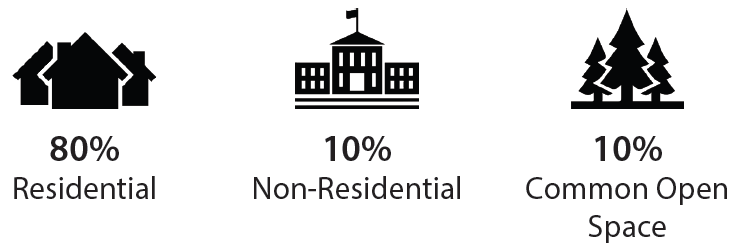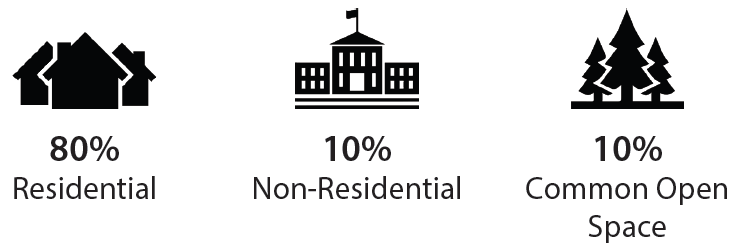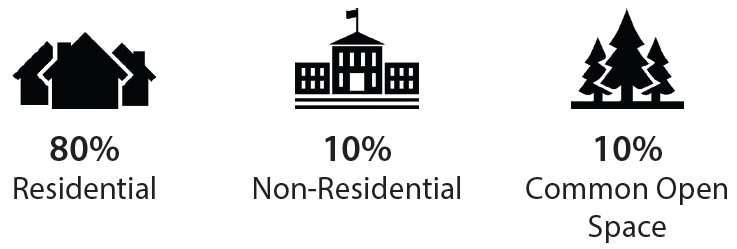Placing Place Types (Neighborhoods and Centers)
Placing Place Types (Neighborhoods and Centers)
Places Types are a way to classify land that explains the types of development that should be allowed. They describe types and intensities of land use as well as important characteristics such as the scale of buildings, site design, and accessibility. The Charlotte Future 2040 Comprehensive Plan will use Place Types to describe preferred development patterns in the city over the next 20 years.
Neighborhood 1
Goals
- Protect character and provide an opportunity for a variety of housing types.
- Integrate Neighborhood 1 into surrounding Neighborhood Place Types to develop complete neighborhoods.
Land Use
- Neighborhood 1 is a primarily residential neighborhood that may also include some civic and institutional uses.
- The predominant types of open spaces are private yards which help create a sense of privacy that is unique to this Place Type. Neighborhood parks may also be located in Neighborhood 1.
Building Types
- A variety of building types provides a range of housing choices and is critical to accommodate our community’s diverse population.
- Primary building types are detached houses and duplexes.
- Lots in Neighborhood 1 may also have accessory dwelling units and detached garages in the rear yard.
- Triplexes and quadruplex may be located on corner lots.
- Non-residential buildings for civic and institutional uses are typically located on Arterial Streets, on corners, and at the edges of neighborhoods.
Typical Mix of Uses
City of Charlotte, NC Survey
Neighborhood 2
Goals
- Accommodate a range of moderate intensity residential housing choices which contribute to citywide housing diversity.
- Integrate Neighborhood 2 into surrounding Neighborhood Place Types to develop complete neighborhoods.
Land Use
- Neighborhood 2 is a residential neighborhood that accommodates a range of moderate intensity housing choices, to provide housing choices for different needs and preferences.
- Common open spaces, neighborhood parks, greenways, and civic/ institutional uses may also be included in Neighborhood 2.
Building Types
- A variety of housing choice is critical for providing housing choices for residents with varying preferences and household sizes.
- Primary building types are townhomes, house courts, and similar attached units.
- Single family, duplexes, triplexes, and quadraplexes are also appropriate.
- Non-residential buildings for civic and institutional uses are typically located on Arterial Streets and corners.
Typical Mix of Uses
City of Charlotte, NC Survey
Neighborhood 3
Goals
- Provide a range of moderate to higher intensity housing choices to meet the needs of a diverse population.
- Integrate Neighborhood 3 into surrounding Neighborhoods and more intense Place Types to develop complete Neighborhoods.
Land Use
- Primarily multi-family residential area that accommodates a range of housing choices.
- Residents in Neighborhood 3 typically share community amenities such as open spaces, recreational facilities, and parking areas with other residents.
Building Types
- A variety of building types provides a range of housing choices and is critical to accommodating our community’s diverse populations.
- Primary building types are low- to mid-rise multi-family buildings. Low- to Mid-rise mixed use buildings with limited ground floor non-residential uses may be appropriate in some areas, typically near a Neighborhood Node, Center or along an Arterial Street.
- Smaller single and multi-family building types such as houses, duplexes, triplexes, quadraplexes, and townhouses are also appropriate in Neighborhood 3.
- Primary non-residential buildings for civic and institutional uses are typically located on Arterial Streets, on corners, and at the edges of neighborhoods.
Typical Mix of Uses
City of Charlotte, NC Survey
Neighborhood Center
Goals
- Be the focal point for the surrounding neighborhood and designed to be a pedestrian-friendly concentration of neighborhood commercial activity.
- Provide daily services to residents within a 5-10 minute walk or drive.
- Designed to fit within the context of the surrounding area and be accessible by all modes of transportation.
Land Use
- A mixed use place that offers higher intensity residential uses and neighborhood services, like a grocery store, offices, and institutional uses.
Building Types
- The main building type is low-rise commercial, but low to mid-rise mixed use and multi-family buildings are frequently found in a Neighborhood Center.
- Some buildings may be single use.
- All buildings should provide ground floor activation, particularly along Local Streets, Avenues with on-street parking, and Main Streets.
City of Charlotte, NC Survey
The questions marked with a red border are required.
Copy Project
This is hidden text that lets us know when google translate runs.



